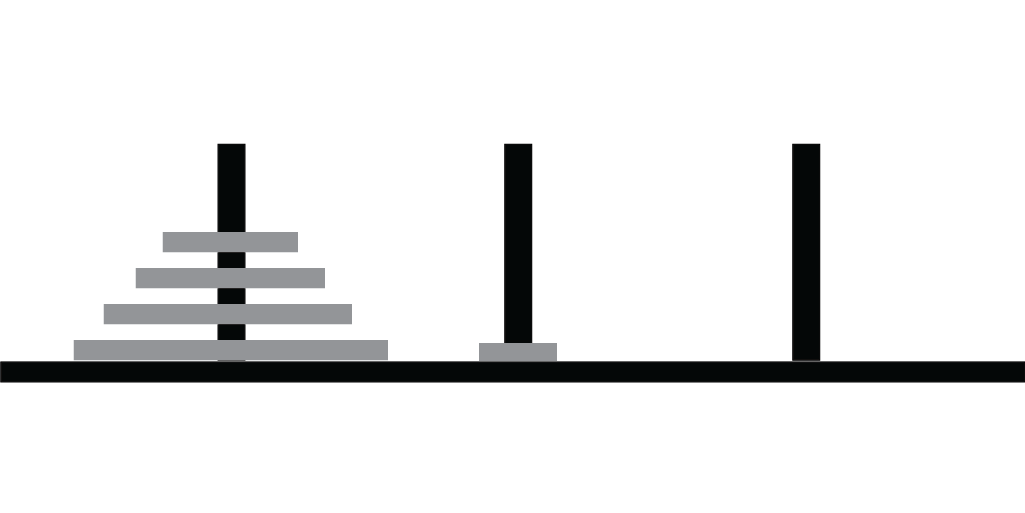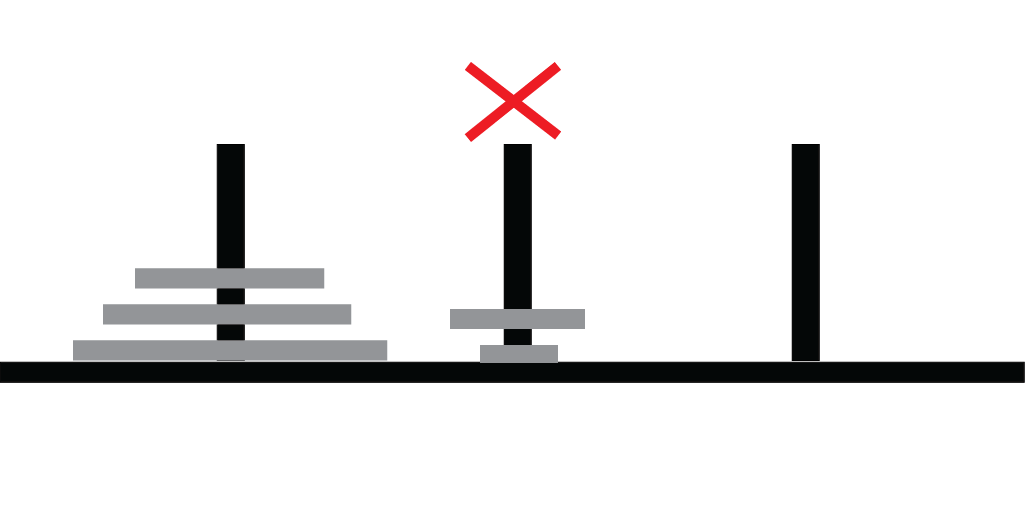Lecture 04: Recursion III
Outline
- Tower of Hanoi
- recursive strategy
- in code
- Concluding Thoughts on Recursion
- Preview: Defining New Objects
Last Time: Tower of Hanoi
Setup

Goal

Rules


A Program
Want:
- A program that generates instructions for a solution
- Example solution for 2 disks
Move disk from peg 1 to peg 2
Move disk from peg 1 to peg 3
Move disk from peg 2 to peg 3
Solution for 3 Disks?
Moving the Largest Disk
How to move largest disk from peg 1 to peg 3?
Solving in 3 Steps (1)
Step 1: Move subtower to peg 2

Solving in 3 Steps (2)
Step 2: Move bottom disk to peg 3

Solving in 3 Steps (3)
Step 3: Move subtower to peg 3

Moving a Sub-Tower
How do we move \(m\) disks from peg \(i\) to peg \(j\)?
A General Procedure
To move \(m\) disks from peg \(i\) to \(j\):
- move \(m - 1\) disks from \(i\) to \(k\) (other peg)
- move one disk from \(i\) to \(j\)
- move \(m - 1\) disks from \(k\) to \(j\)
What is missing?
Base Case!
If \(m = 1\), just print
Move disk from peg i to peg j
Let’s try it in code!
How Efficient is our Solution?
void move (int m, int from, int to, int other) {
if (m == 1) {
System.out.println("Move disk from " + from + " to " + to);
return;
}
move(m - 1, from, other, to);
move(1, from, to, other);
move(m - 1, other, to, from);
}
Counting Recursive Calls
If \(f(m )\) is number of instructions printed to move \(m\) disks:
- \(f(m) = 2 \cdot f(m-1) + f(1)\), and \(f(1) = 1\)
- So we get:
- $f(1) = 1$
- $f(2) = 2 \cdot f(1) + 1 = 3$
- $f(3) = 2 \cdot f(2) + 1 = 7$
- $\vdots$
- $f(m) = 2^m - 1$
- This is a lot of instructions!
- $f(10) \approx 1,000$, $f(20) \approx 1,000,000$, $f(30) \approx 1,000,000,000$
But…
Solving Tower of Hanoi with $m$ disks requires $2^m - 1$ instructions!
- The solution generated by our program is optimal
- Requires only 5 lines of code!
Concluding Thoughts on Recursion
Factorial
private static int factorial(int n) {
if (n == 1) return 1;
return n * factorial(n - 1);
}
Fibonacci
private static int fibonacci (int n) {
if (n <= 2) return 1;
return fibonacci(n - 1) + fibonacci(n - 2);
}
Tower of Hanoi
private static void move (int num, int from, int to, int other) {
if (num == 1) {
System.out.println("Move disk from " + from + " to " + to + "." );
return;
}
move(num - 1, from, other, to);
move(1, from, to, other);
move(num - 1, other, to, from);
}
Evaluation
- Factorial: simple code and efficient execution
- Fibonacci: simple code, but inefficient execution
- ToH: surprisingly simple; perhaps mysterious; large solution
- but solution is still optimal
Moral
Recursion is…
- subtle
- sometimes efficient, sometimes not
- powerful
- miraculous
- confusing
How Confusing?
public static long collatz (long n) {
if (n == 1) return 1;
if (n % 2 == 0) return collatz (n / 2);
else return collatz (3 * n + 1);
}
Insanity
public static long collatz (long n) {
if (n == 1) return 1;
if (n % 2 == 0) return collatz (n / 2);
else return collatz (3 * n + 1);
}
- It is not known if this method has an infinite loop for some value of
n - This is not for lack of interest in the problem:
- Worked on by some of the most celebrated mathematicians of the last century